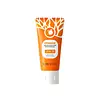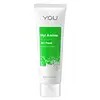What's inside
What's inside
 Key Ingredients
Key Ingredients

 Benefits
Benefits

 Concerns
Concerns

 Ingredients Side-by-side
Ingredients Side-by-side

Water
Skin ConditioningCarbomer
Emulsion StabilisingDipropylene Glycol
HumectantDodecylbenzyltrimonium Chloride
AntimicrobialPEG-40 Hydrogenated Castor Oil
EmulsifyingParfum
MaskingEthylhexylglycerin
Skin ConditioningLactose
HumectantCitrus Aurantium Dulcis Peel Oil
MaskingLactobacillus/Milk Ferment Filtrate
Skin ConditioningPseudoalteromonas Ferment Extract
HumectantBacillus
Skin ConditioningNiacinamide
Smoothing3-O-Ethyl Ascorbic Acid
Skin ConditioningGlutathione
Pearl Extract
AntioxidantSalicylic Acid
MaskingHamamelis Virginiana Water
AstringentGlycolic Acid
BufferingLactic Acid
BufferingSea Salt
AbrasiveJojoba Esters
EmollientTitanium Dioxide
Cosmetic ColorantTocopheryl Acetate
AntioxidantAscorbyl Palmitate
AntioxidantCarnosine
Skin ConditioningGlycyrrhiza Glabra Root
Skin ConditioningFolic Acid
Skin ConditioningCynanchum Atratum Extract
Skin ConditioningCeramide As
Skin ConditioningCeramide Ns
Skin ConditioningCeramide AP
Skin ConditioningCeramide EOP
Skin ConditioningSodium Hyaluronate
HumectantCellulose
AbsorbentMicrocrystalline Cellulose
AbsorbentCI 77891
Cosmetic ColorantCI 77499
Cosmetic ColorantMannitol
HumectantHydroxypropyl Methylcellulose
Emulsion StabilisingHydrogenated Lecithin
EmulsifyingZea Mays Starch
AbsorbentDisodium EDTA
Mica
Cosmetic ColorantEthylcellulose
PEG-150
HumectantCI 77492
Cosmetic ColorantAcrylates/C10-30 Alkyl Acrylate Crosspolymer
Emulsion StabilisingPhenoxyethanol
PreservativeButylene Glycol
Humectant1,2-Hexanediol
Skin ConditioningMethylparaben
PreservativeCaprylyl Glycol
EmollientGlycerin
HumectantPentylene Glycol
Skin ConditioningWater, Carbomer, Dipropylene Glycol, Dodecylbenzyltrimonium Chloride, PEG-40 Hydrogenated Castor Oil, Parfum, Ethylhexylglycerin, Lactose, Citrus Aurantium Dulcis Peel Oil, Lactobacillus/Milk Ferment Filtrate, Pseudoalteromonas Ferment Extract, Bacillus, Niacinamide, 3-O-Ethyl Ascorbic Acid, Glutathione, Pearl Extract, Salicylic Acid, Hamamelis Virginiana Water, Glycolic Acid, Lactic Acid, Sea Salt, Jojoba Esters, Titanium Dioxide, Tocopheryl Acetate, Ascorbyl Palmitate, Carnosine, Glycyrrhiza Glabra Root, Folic Acid, Cynanchum Atratum Extract, Ceramide As, Ceramide Ns, Ceramide AP, Ceramide EOP, Sodium Hyaluronate, Cellulose, Microcrystalline Cellulose, CI 77891, CI 77499, Mannitol, Hydroxypropyl Methylcellulose, Hydrogenated Lecithin, Zea Mays Starch, Disodium EDTA, Mica, Ethylcellulose, PEG-150, CI 77492, Acrylates/C10-30 Alkyl Acrylate Crosspolymer, Phenoxyethanol, Butylene Glycol, 1,2-Hexanediol, Methylparaben, Caprylyl Glycol, Glycerin, Pentylene Glycol
Water
Skin ConditioningSodium Laureth Sulfate
CleansingCocamidopropyl Betaine
CleansingSodium Lauryl Sulfate
CleansingSekken Soji
CleansingSodium Chloride
MaskingGlycol Distearate
EmollientDecyl Glucoside
CleansingPhenoxyethanol
PreservativeSodium Benzoate
MaskingPotassium Laureth Phosphate
EmulsifyingDistearyl Phthalic Acid Amide
EmollientCocamide Mea
EmulsifyingAcrylates Copolymer
PEG-120 Methyl Glucose Dioleate
EmulsifyingPEG-40 Hydrogenated Castor Oil
EmulsifyingGlycerin
HumectantCitric Acid
BufferingDisodium EDTA
Melaleuca Alternifolia Leaf Oil
AntioxidantButylene Glycol
HumectantCentella Asiatica Extract
CleansingSalicylic Acid
MaskingHyaluronic Acid
HumectantPentylene Glycol
Skin ConditioningMoringa Oleifera Seed Extract
Skin ConditioningSerine
MaskingHistidine
HumectantThreonine
Aspartic Acid
MaskingSodium Acetylated Hyaluronate
HumectantSodium Hyaluronate
Humectant1,2-Hexanediol
Skin ConditioningSodium Hyaluronate Crosspolymer
HumectantHydroxyacetophenone
AntioxidantHydrolyzed Sodium Hyaluronate
Skin ConditioningEthylhexylglycerin
Skin ConditioningCI 19140
Cosmetic ColorantCI 42090
Cosmetic ColorantWater, Sodium Laureth Sulfate, Cocamidopropyl Betaine, Sodium Lauryl Sulfate, Sekken Soji, Sodium Chloride, Glycol Distearate, Decyl Glucoside, Phenoxyethanol, Sodium Benzoate, Potassium Laureth Phosphate, Distearyl Phthalic Acid Amide, Cocamide Mea, Acrylates Copolymer, PEG-120 Methyl Glucose Dioleate, PEG-40 Hydrogenated Castor Oil, Glycerin, Citric Acid, Disodium EDTA, Melaleuca Alternifolia Leaf Oil, Butylene Glycol, Centella Asiatica Extract, Salicylic Acid, Hyaluronic Acid, Pentylene Glycol, Moringa Oleifera Seed Extract, Serine, Histidine, Threonine, Aspartic Acid, Sodium Acetylated Hyaluronate, Sodium Hyaluronate, 1,2-Hexanediol, Sodium Hyaluronate Crosspolymer, Hydroxyacetophenone, Hydrolyzed Sodium Hyaluronate, Ethylhexylglycerin, CI 19140, CI 42090
 Reviews
Reviews

Ingredients Explained
These ingredients are found in both products.
Ingredients higher up in an ingredient list are typically present in a larger amount.
1,2-Hexanediol is a synthetic liquid and another multi-functional powerhouse.
It is a:
- Humectant, drawing moisture into the skin
- Emollient, helping to soften skin
- Solvent, dispersing and stabilizing formulas
- Preservative booster, enhancing the antimicrobial activity of other preservatives
Butylene Glycol (or BG) is used within cosmetic products for a few different reasons:
Overall, Butylene Glycol is a safe and well-rounded ingredient that works well with other ingredients.
Though this ingredient works well with most skin types, some people with sensitive skin may experience a reaction such as allergic rashes, closed comedones, or itchiness.
Learn more about Butylene GlycolDisodium EDTA plays a role in making products more stable by aiding other preservatives.
It is a chelating agent, meaning it neutralizes metal ions that may be found in a product.
Disodium EDTA is a salt of edetic acid and is found to be safe in cosmetic ingredients.
Learn more about Disodium EDTAEthylhexylglycerin (we can't pronounce this either) is commonly used as a preservative and skin softener. It is derived from glyceryl.
You might see Ethylhexylglycerin often paired with other preservatives such as phenoxyethanol. Ethylhexylglycerin has been found to increase the effectiveness of these other preservatives.
Glycerin is already naturally found in your skin. It helps moisturize and protect your skin.
A study from 2016 found glycerin to be more effective as a humectant than AHAs and hyaluronic acid.
As a humectant, it helps the skin stay hydrated by pulling moisture to your skin. The low molecular weight of glycerin allows it to pull moisture into the deeper layers of your skin.
Hydrated skin improves your skin barrier; Your skin barrier helps protect against irritants and bacteria.
Glycerin has also been found to have antimicrobial and antiviral properties. Due to these properties, glycerin is often used in wound and burn treatments.
In cosmetics, glycerin is usually derived from plants such as soybean or palm. However, it can also be sourced from animals, such as tallow or animal fat.
This ingredient is organic, colorless, odorless, and non-toxic.
Glycerin is the name for this ingredient in American English. British English uses Glycerol/Glycerine.
Learn more about GlycerinPeg-40 Hydrogenated Castor Oil is derived from castor oil and polyethylene glycol (PEG). It is used as a emollient and emulsifier.
As an emulsifier, it helps prevent ingredients from separating. It also helps make the other ingredients more soluble; it is often used to solubilize fragrances. This increases spreadability and elongates shelf life in a product.
Emollients help soothe and soften the skin. They do this by creating a protective film on your skin. This barrier helps trap moisture and keeps your skin hydrated. Emollients may be effective at treating dry or itchy skin.
This ingredient may or may not be vegan, depending on the source.
Peg-40 Hydrogenated Castor Oil may not be fungal-acne safe. We recommend speaking with a professional if you have any questions or concerns.
Learn more about PEG-40 Hydrogenated Castor OilPentylene glycol is typically used within a product to thicken it. It also adds a smooth, soft, and moisturizing feel to the product. It is naturally found in plants such as sugar beets.
The hydrophilic trait of Pentylene Glycol makes it a humectant. As a humectant, Pentylene Glycol helps draw moisture from the air to your skin. This can help keep your skin hydrated.
This property also makes Pentylene Glycol a great texture enhancer. It can also help thicken or stabilize a product.
Pentylene Glycol also acts as a mild preservative and helps to keep a product microbe-free.
Some people may experience mild eye and skin irritation from Pentylene Glycol. We always recommend speaking with a professional about using this ingredient in your routine.
Pentylene Glycol has a low molecular weight and is part of the 1,2-glycol family.
Learn more about Pentylene GlycolPhenoxyethanol is a preservative that has germicide, antimicrobial, and aromatic properties. Studies show that phenoxyethanol can prevent microbial growth. By itself, it has a scent that is similar to that of a rose.
It's often used in formulations along with Caprylyl Glycol to preserve the shelf life of products.
Salicylic Acid (also known as beta hydroxy acid or BHA) is a well-known ingredient for treating skin that struggles with acne and clogged pores. It exfoliates both the skin's surface and deep within the pores to help clear out buildup, control oil, and reduce inflammation.
Unlike AHAs (alpha hydroxy acids), salicylic acid is oil-soluble. This allows it to penetrate into pores which makes it especially effective for treating blackheads and preventing future breakouts.
Salicylic acid is also known for its soothing properties. It has a similar structure to aspirin and can calm inflamed or irritated skin, making it a good option for acne-prone skin that is also sensitive.
Concentrations of 0.5-2% are recognized by the U.S. FDA as an over-the-counter topical acne product.
It can cause irritation and/or dryness if one's skin already has a compromised moisture barrier, so it's best to focus on repairing that before introducing this ingredient into your routine.
While salicylic acid does not increase sun sensitivity, it’s still important to wear sunscreen daily to protect your skin.
If you are looking for the ingredient called BHA or Butylated Hydroxyanisole, click here.
Learn more about Salicylic AcidSodium Hyaluronate is hyaluronic acid's salt form. It is commonly derived from the sodium salt of hyaluronic acid.
Like hyaluronic acid, it is great at holding water and acts as a humectant. This makes it a great skin hydrating ingredient.
Sodium Hyaluronate is naturally occurring in our bodies and is mostly found in eye fluid and joints.
These are some other common types of Hyaluronic Acid:
Learn more about Sodium HyaluronateWater. It's the most common cosmetic ingredient of all. You'll usually see it at the top of ingredient lists, meaning that it makes up the largest part of the product.
So why is it so popular? Water most often acts as a solvent - this means that it helps dissolve other ingredients into the formulation.
You'll also recognize water as that liquid we all need to stay alive. If you see this, drink a glass of water. Stay hydrated!
Learn more about Water